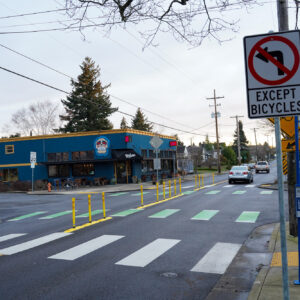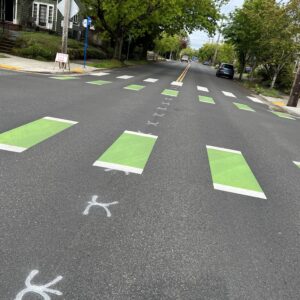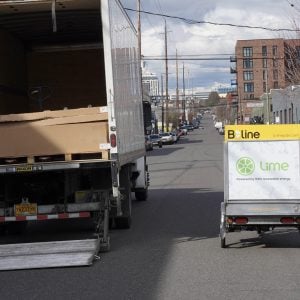The City of Portland says a neighborhood traffic diverter that was vehemently opposed by many residents of a northeast Portland neighborhood is working as planned.
When the Beaumont-Wilshire Neighborhood Association put the planned diverter on Northeast Fremont at Alameda on a meeting agenda in March 2022, over 70 people logged on. Many of them voiced concerns that the expected safety benefits of the project would not be worth a loss of convenience while driving and/or an increase in cut-through traffic.
The Portland Bureau of Transportation proposed the diverter to improve safety on NE Fremont (a neighborhood collector street), make it easier for bikers and walkers to cross at Alameda, and reduce the amount of drivers on the Alameda/37th neighborhood greenway route. Even though PBOT’s plan was to only make it a pilot project, the BWNA board voted it down 7-4.
After months of back-and-forth with members of the board, PBOT decided to push forward with their plan despite the neighbor’s concerns. The project included a diverter made with plastic delineator wands and curbs placed in the middle of the intersection with gaps for walkers and bikers to cross. The diverter prohibits car users from crossing north-south on Alameda and from making left turns from any direction. PBOT also added green cross-bike markings.
PBOT released results of an analysis of traffic counts on streets in the area earlier this week (see below). In a statement posted on the project’s (rather comprehensive and large for a project this size) website PBOT said, “The project is meeting success factors outlined before implementation.”
According to PBOT data collected at 22 locations before the project and 15 locations after installation, there’s been a significant decrease in car users on the Alameda greenway and there have been “no significant impacts” to nearby local streets or to traffic on NE Fremont.
In May 2022, PBOT counted 1,073 cars on the Alameda greenway north of Fremont (blue circle above). In September of this year (about seven months after the diverter was installed), PBOT counted 701 cars at the same location — a 35% reduction. (PBOT’s guidelines say traffic volume, “should not exceed 1,000 cars per day” on neighborhood greenway streets.)
When PBOT installs a diverter, they expect some additional trips by car on adjacent local streets. That’s why they do so much analysis: If the daily auto volume rises above the threshold amount of 1,000 cars per day, PBOT will consider additional changes and/or more diversion until the traffic moves to the highest order street in the area.
On that note, there are two streets PBOT says they’ll continue to monitor due to a worrying trend of too many cars: NE 38th south of Fremont and NE Klickitat west of Alameda.
The increase of drivers on that section of Klickitat (see orange circle above) is notable because not only is it a neighborhood greenway, it’s also the route of the World Famous Alameda Elementary School Bike Bus. In May 2022 PBOT counted 650 cars per day on Klickitat just west of NE 37th. After the diverter went in, they counted 1,005 trips by car on Klickitat just east of Alameda. This 35% increase is troubling and PBOT says they’ll continue to monitor the location.
This and other issues related to the project will be discussed at a meeting of the BWNA on December 11th where PBOT staff will present results of this report.









Thanks for reading.
BikePortland has served this community with independent community journalism since 2005. We rely on subscriptions from readers like you to survive. Your financial support is vital in keeping this valuable resource alive and well.
Please subscribe today to strengthen and expand our work.
This article combined with the 122nd death telling a pretty accurate and depressing story about the state of our transportation investments. We are not moving fast enough. So much staff time has gone into this one diverter. It is important, but we need to be more closely adhering to our policy around traffic safety instead of such time consuming public processes.
So true, Kiel. If it were some automotive improvement, PBOT would just do it and tell us all that it was necessary.
But if it’s a cycling/ped improvement, there’s a lengthy public-involvement process that takes months and even years.
Clearly we are NOT moving fast enough.
Good thing, it didn’t include fixing ADA ramps, it would never have gotten done.
Unfortunately, one of the problems the BWNA highlighted still remains and the diverter didn’t really fix it — drivers driving too fast on Fremont. There were motion activated speed detector signs in both directions that were great but they were apparently temporary, gone a few months after the diverters were installed.
We need speed cameras everywhere. Aside from building raised crosswalks, there isn’t really much you can do to signal (slow down, business district!) on this street. People are just sociopaths and they need to be punished for their antisocial behavior.
Crossing this exact diverter is on my daily commute. Going both ways, I always get a break in traffic or a car stops within seconds of me arriving there.
Maybe your experience is different but I have had absolutely zero problems at this intersection. Maybe me towing a kid trailer makes people more sympathetic.
You also live and commute in a very wealthy nice neighborhood.
These kind of wand/paint things work better in those.
You don’t know where I live, bikes can go far. And that neighborhood is what this comment thread is about, so it seemed relevant. Also I don’t believe the same wouldn’t work in any neighborhood.
I think they are referring specifically to vandalism and the propensity for folks to damage the infrastructure in stolen cars, which is unfortunately a thing. This is my main bicycle route too from Failing/MLK all the way into SE.
The speeding issue applies to all of Fremont, not in just this location. It gets especially crazy east of 42nd, where the commercial district is even busier. If you ever drive through here, try going 20mph and watch what happens behind you.
When I do drive down Freemont, I drive exactly the speed limit, and I’ve had several people pass me in the oncoming lane because I was driving too slow.
Noticed this happening more and more recently it’s kinda hard to keep a count of the number of people that have recklessly passed me in the median or oncoming lanes all over the city.
And remember traffic cameras don’t work on those not displaying license plates or temporary permits. I see that a lot in Portland.
Too bad people don’t have a way of knowing how fast they are driving on Fremont. If only they had some device INSIDE of their vehicles to tell them how fast they are going. Maybe one day ….
Are you suggesting that people take their eyes off the road to look at said device? Do you even know how much damage someone going 55 down Fremont could do if they take their eyes off the road to check some big-brother, nanny-state, speed device?
I have noticed 15th and 21st in NE have speed bumps on them and are major streets. Why doesn’t Fremont get speed bumps?
Feel this exact way – folks need to slow their roll on Fremont. The section between 13th and 7th is especially bad as the road opens a bit heading west at Irving park and people speed up to make the light at 7th.
The two locations circled in orange aren’t exactly comparable. Almost all of the car traffic coming up the hill on NE 38th from NE Knott will head E on Klickitat St. The car volume is concerning but I wouldn’t think of those numbers as a change.
Both NE 38th and NE Klickitat have signs indicating they are greenways or some neighborhood street type thing but since there are no internal diverters they are used by drivers ducking the congestion and signals on nearby collector streets.
This was my complaint. Not only is it really annoying that they’re taking measurements at different times of year (I don’t know how much that changes but it’s a needless variable), but yeah, they measured at very different places there. They cannot conclude that traffic increased.
They did not detect an increase, 35% or any other number. They measured two numbers that cannot be compared.
PBOT’s traffic studies are generally low quality. My favorite is when they proclaimed that the beg barrels they installed on greenways worked because traffic was down. They didn’t seem to think traffic might be down because their second measurement was from summer 2020 and the height of COVID and WFH and their original measure was from before COVID.
More diverters would help.
It’s horrible how PBOT will or won’t push through safety improvements based on the demographic make up of the community complaints, ensuring that traditionally less served neighborhoods will continue to be more dangerous and car centric in the name of equity.
Compare how they backpedaled on the 7th Ave greenway vs how they moved forward with this project in a more affluent neighborhood.
At the end of the day who will be safer and better served? Who is really winning when you leave streets dangerous to preserve parking or car traffic lanes in “multigenerational neighborhoods” in the name of equity? Is that equity? So bizarre.
When it comes to saving lives, the good of the many (all users of public right of way in Portland) must take precedence over the inconvenience of a few (in this case the neighborhood association of one of Portland’s more affluent neighborhoods, but this applies generally to all neighbothoods). Seeking community input is good, but if that were the main determinant always, we’d live in a much more regressive society.
“Saving lives” is not a useful metric in places that rarely if ever see cyclists killed. If it’s all about “saving lives”, why are we wasting time doing anything anywhere but high crash corridors, and doing anything for cyclists, who, fortunately, have a pretty low fatality rate compared to other modes?
Nice of them to highlight that drivers were exceeding the speed limit by 50% on Fremont at 40th some 11 years ago. I wonder if it’s still that bad. I’m guessing it is since the speed limit didn’t change.
It’s just like the apocalyptic rose lane in Hillsdale: people predict chaos and locusts and death if *any* aspect of their automobility is limited.
But the result is more mundane. I kinda like how motorists get to experience some of the limitations that cyclists labor under every day.
I ride through there. It really never seemed to be a problem area and now PBOT just moved traffic elsewhere. The issue is traffic speed limits are STILL NOT ENFORCED on Fremont. Doesn’t sound like success to me but PBOT says it is. LOL.
It is great that this pilot project has confirmed that this was a needed infrastructure improvement, however I still see people driving cars drive through the wands to perform a forbidden movement, I hope the city plans to replace this visual barrier with a physical one.
I am happy for Alameda but given the source I’m going to take claims of success and follow up with a grain of salt.
This week alone I’ve learned enough about the inner workings of City Hall to see Terry Gilliam’s Brazil made manifest. As much as the city does need charter reform, I think we’re going to be very disappointed with the results. A commissioner is seemingly the only person who empowers anybody working for the city to solve problems.
“I think we’re going to be very disappointed with the results. A commissioner is seemingly the only person who empowers anybody working for the city to solve problems.”
That’s a Bingo!
It’s worth noting that Google Maps routes cars from NE 42nd and Prescott to Hollywood or Laurelhurst along 38th instead of 42nd. That’s probably not helping the traffic along that narrow street.
No it doesn’t. People drive through them if they want because the gaps are wide enough that even SUVs fit through them. I’ve seen it happen numerous times.
It baffles me why they keep putting this kind of diverter up everywhere. It’s the same with the gaps in the speed bumps they put on all the greenways. Why the hell are they the perfect width for large vehicles to just fly through them?
It’s the “Portland Nice” dilemma. People who follow the laws don’t fly through them, myself being one. The ones that don’t care about others on the streets will fly through them or over. I’ve seen plenty of 40+ mph drivers flying over the bumps on my neighborhood street. Surprisingly not youngsters but many I’ve seen are 60+ in my hood.
Tacovore is right there by the way. It’s been a huge improvement. Klickitat has been an issue since forever I think the main problem is if you block the exit people will literally trap themselves in the dead end at a steep grade and there’s not enough space to reconstruct into a loop or roundabout.
The increase on the other greenway is interesting. Can’t speak to this specific section/street but over in my neighborhood the greenways (with their lack of stop signs and wide sight lines) can be a preferable way to cross the neighborhood. As long as one has the diverters memorized, and the appropriate work arounds, at peak times taking the Lincoln greenway from 55th to 20th is much faster than Division or Hawthorne.
“is a success PBOT says”. said the extremely incompetent public works agency of the City government that can’t figure out how to setup a sidewalk without building and demolishing three times, and finally getting it right on the 4th try.
This novel is rated 5 stars, said the author, who rated it himself.
According to PBOT data collected at 22 locations before the project and 15 locations after installation. This makes all of the data and assumptions they make completely meaningless. They are potentially hiding all of the data that does not fit their narrative.
Let’s do some farmers math 1073 – 701 = 372 less cars, 30 days in a month, 372/30 = 12.4cars per day less. 24 hours in a day 12.4/ 24 = .5 cars per hour. Hardly seems worth the headline much less the aesthetic skid-mark in alameda’s neighborhood. That’s taking their numbers at face value, which as others pointed out seems kind of wonky using September vs May. We really don’t know what the monthly variant is. Much less core hours of use etc. Junk reporting.
Farmer’s seem to do their math in a very strange way. The 372 less cars was per day so it makes no sense to divide by 30 just because that is how many days are in some months. It also doesn’t take a traffic engineer to understand that rush hour wouldn’t exist if car usage was equal throughout the day. Seems like especially at busy times we are talking dozens of cars per hour not 1 every couple of hours.
As I mentioned “We really don’t know what the monthly variant is. Much less core hours of use etc.”